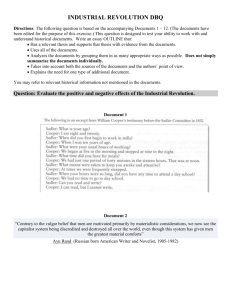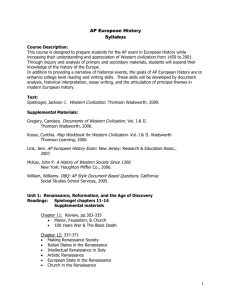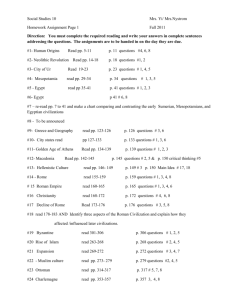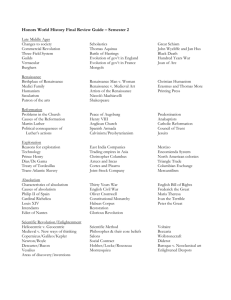AP European History - Ottawa Hills Schools
advertisement
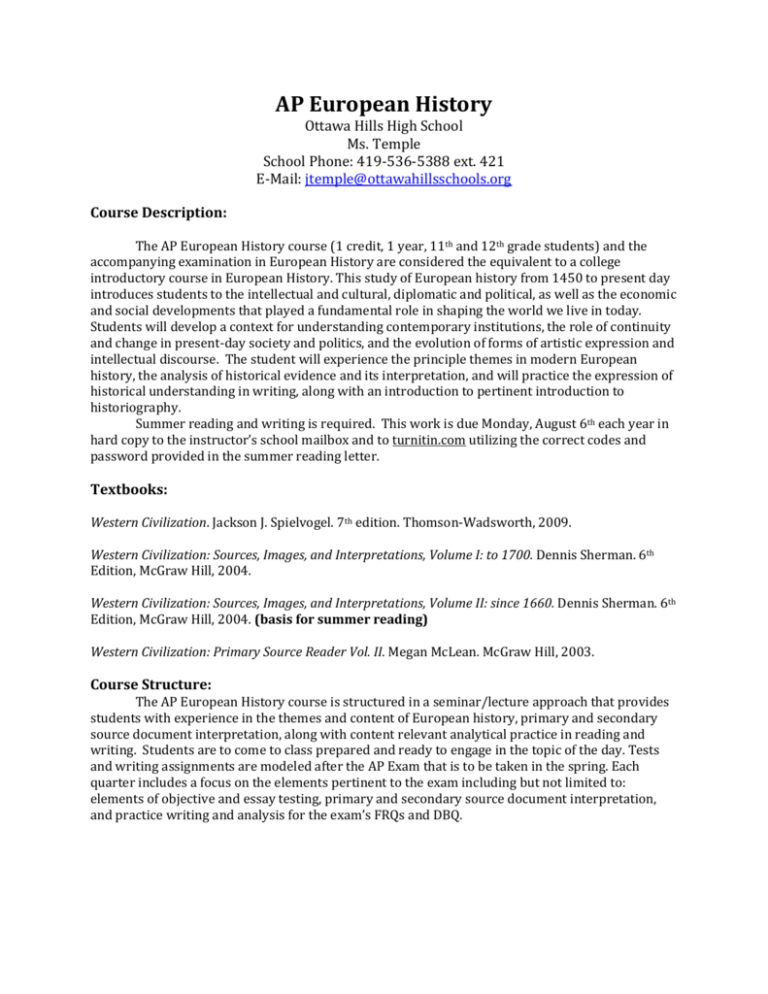
AP European History Ottawa Hills High School Ms. Temple School Phone: 419-536-5388 ext. 421 E-Mail: jtemple@ottawahillsschools.org Course Description: The AP European History course (1 credit, 1 year, 11th and 12th grade students) and the accompanying examination in European History are considered the equivalent to a college introductory course in European History. This study of European history from 1450 to present day introduces students to the intellectual and cultural, diplomatic and political, as well as the economic and social developments that played a fundamental role in shaping the world we live in today. Students will develop a context for understanding contemporary institutions, the role of continuity and change in present-day society and politics, and the evolution of forms of artistic expression and intellectual discourse. The student will experience the principle themes in modern European history, the analysis of historical evidence and its interpretation, and will practice the expression of historical understanding in writing, along with an introduction to pertinent introduction to historiography. Summer reading and writing is required. This work is due Monday, August 6th each year in hard copy to the instructor’s school mailbox and to turnitin.com utilizing the correct codes and password provided in the summer reading letter. Textbooks: Western Civilization. Jackson J. Spielvogel. 7th edition. Thomson-Wadsworth, 2009. Western Civilization: Sources, Images, and Interpretations, Volume I: to 1700. Dennis Sherman. 6th Edition, McGraw Hill, 2004. Western Civilization: Sources, Images, and Interpretations, Volume II: since 1660. Dennis Sherman. 6th Edition, McGraw Hill, 2004. (basis for summer reading) Western Civilization: Primary Source Reader Vol. II. Megan McLean. McGraw Hill, 2003. Course Structure: The AP European History course is structured in a seminar/lecture approach that provides students with experience in the themes and content of European history, primary and secondary source document interpretation, along with content relevant analytical practice in reading and writing. Students are to come to class prepared and ready to engage in the topic of the day. Tests and writing assignments are modeled after the AP Exam that is to be taken in the spring. Each quarter includes a focus on the elements pertinent to the exam including but not limited to: elements of objective and essay testing, primary and secondary source document interpretation, and practice writing and analysis for the exam’s FRQs and DBQ. Assignments: There will be a variety of assessments in AP European History, all of which are geared towards preparation for the May AP test. Your grade will depend on the your performance on the following assessments: 1. Multiple Choice Tests 2. Free Response Questions (FRQs) 3. Document Based Questions (DBQs) 4. Reading Quizzes 5. Group work 6. Class Participation There will be at least one graded assignment per week. Whether it is a chapter test, in class DBQ, or a quiz over the previous night’s reading. Chapter tests, FRQs, and DBQs will all be announced ahead of time, however, reading quizzes will not be announced. You can expect at least one reading quiz per chapter. This will ensure that you are not only keeping up with the outside reading but it will also help with the day’s lecture and subsequent class discussions. This year, chapter notes should be taken during lecture and as you read the textbook, however, you will not be turning them in for credit. Lectures are designed to discuss in depth the most important parts of the chapter so quality note taking is critical. This course will also include a strong focus on visual sources including maps, charts, graphs, along with art and the interpretation of art. Paintings, drawings, illustrations, sculptures, architecture, and photography will be heavily integrated into the course structure. Expect to see the aforementioned visual sources throughout the semester during lectures and included on tests, quizzes, DBQs, and group work. Your ability to interpret visual sources is a key component to success on the AP test. Test corrections will occur before school, during lunch, or after school on the day(s) set up by the instructor (usually the day or two after the test is passed back). Test corrections WILL NOT occur during study halls, in other classes, or while there are other classes are in session, no exceptions! Grading Policy: Your grade will be determined by the percentage of points you earn compared to the total points offered during the term. The grading scale: 92-100% 82-91% 72-81% 64-71% Below 64% - A B C D F Topic Syllabus: First Quarter Chapter 11: The Later Middle Ages: Crisis and Disintegration in the Fourteenth Century. Black death & social crisis War & political instability Decline of the church Cultural world of the 14th century Society in an age of adversity Chapter 12: Recovery and Rebirth: The Age of the Renaissance. Meaning & characteristics of the Italian Renaissance Origins of Renaissance society Italian states in the Renaissance Intellectual Renaissance in Italy Artistic Renaissance European states in the Renaissance Church un the Renaissance Humanism as a prelude to the Reformation Martin Luther & the Reformation in Germany Spread of the Protestant Reformation Social impact of the Protestant Reformation The Catholic Reformation Politics & wars of religion in the 16th century Chapter 13: Reformation and Religious Warfare in the Sixteenth Century. Chapter 14: Europe and the World: New Encounters, 1500-1800. Transition to a new world News horizons: Portuguese & Spanish empires Rivalry on the world stage Toward a world economy Impact of European expansion Chapter 15: State Building and the Search for Order in the Seventeenth Century. Social Crises, war & rebellions Absolutism in Western Europe Absolutism in Central, Eastern & Northern Europe Limited monarchy & republics 17th century European art & theater Chapter 16: Toward a New Heaven and a New Earth: The Scientific Revolution and the Emergence of Modern Science. Background of the Scientific Revolution Revolution in Astronomy Advances in medicine & chemistry Women & modern science Descartes, rationalism & new views of man Scientific method & the spread of scientific knowledge Tests: 5 Objective/Subjective tests: multiple choice and FRQs Reading quizzes (at least one per chapter) Supplemental Readings: Background and primary source readings Completion of primary and secondary source readings along with visual source interpretation and supplemental questions in Western Civilization; Vol. I: Chapter 11-16 and Western Civilization; Vol. II: Chapter 17 Writing: Introduction to essay writing and commonly used task words and phrases Introduction to essay rubrics, especially the DBQ rubric Introduction to the AP European DBQ (German peasant revolts) Partnered DBQ assignment (Elizabeth I) Take home DBQ assignment (Scientific Revolution) Second Quarter Chapter 17: The Eighteenth Century: An Age of Enlightenment. The Enlightenment, the philosophes & their ideas Culture & society in the Enlightenment Religion & the churches Chapter 18: The Eighteenth Century: European States, International Wars, and Social Change. 18th century European states Wars & diplomacy Economic expansion & social change Social order of the 18th century Chapter 19: A Revolution in Politics: The Era of the French Revolution and Napoleon. Roots of the revolutionary era American Revolution Background to the French Revolution The French Revolution Age of Napoleon Chapter 20: The Industrial Revolution and Its Impact on European Society. The Industrial Revolution in Great Britain Spread of industrialization Social impact of the Industrial Revolution Chapter 21: Reaction, Revolution, and Romanticism, 1815-1850. The conservative order (1815-1830) – Concert of Europe Ideologies of change: Liberalism, Nationalism & Early Socialism Revolution & Reform (1830-1850) Emergence of an ordered society Culture in an age of reaction & revolution – Romanticism Chapter 22: An Age of Nationalism and Realism, 1850-1871. Napoleon III’s France National Unification: Italy & Germany The nation-state in Mmd-19th century Industrialization & the Marxist response Science & culture in an age of Realism Tests: 6 Objective/Subjective tests: multiple choice and FRQs Reading quizzes (at least one per chapter) Supplemental Readings: Completion of primary and secondary source readings along with visual source interpretation and supplemental questions in Western Civilization; Vol. II- Chapters 19, 20, 21 and 22 Primary Source Document analysis: Focus on: bias/ point-of-view & how to determine them. Class discussion, group practice and individual writing Writing: Two DBQs (Children in modern Europe, 19th century workers) Third Quarter Chapter 23: Mass Society in an "Age of Progress", 1871-1894. Growth of industrial prosperity Emergence of mass society Modern nation states: Western Europe in comparison to Central & Eastern Europe Chapter 24: An Age of Modernity, Anxiety, and Imperialism, 1894-1914. The modern consciousness: intellectual & cultural developments o Sigmund Freud o Darwin o Modernism in the arts New political directions o Women’s rights o The Jews in modern Europe o Liberalism transformed o Austria-Hungary & nationalities New Imperialism in Africa & Asia International Rivalry & War – Bismarckian System Chapter 25: The Beginning of the Twentieth-Century Crisis: War and Revolution. Road to W.W. I World War I War & revolution: Russia, Germany & Austria-Hungary The peace settlement: Treaty of Versailles Chapter 26: The Futile Search for a New Stability: Europe between the Wars, 1919-1939. Uncertain peace & the Great Depression Status of the democratic states Status of the authoritarian & totalitarian states Spain, dictatorship & civil war Expansion of mass culture & mass leisure Cultural & intellectual trends between the wars Chapter 27: The Deepening of the European Crisis: World War II. Prelude to war (1933-1939) World War II The new order: Nazi empire and the Holocaust War on the home front Aftermath of the war: Cold War Chapter 28: Cold War and a New Western World, 1945-1973. Development of the Cold War Europe & decolonization: Africa, Middle East & Asia Recovery & renewal in Europe Post war society & culture in the western world Tests: 6 Objective/Subjective tests: multiple choice and FRQs Reading quizzes (at least one per chapter) Supplemental Readings: Background and primary source readings Completion of primary and secondary source readings along with visual source interpretation and supplemental questions in Western Civilization; Vol. II – Chapters 23, 24, 25 ,26, 27 Primary Source Analysis: Review of the various categories of “documents,” their potential and limits The nature of authorship and its application to the DBQ Writing: Two DBQs (Imperialism in Africa, Weimar Republic) Fourth Quarter Chapter 29: Protest and Stagnation: The Western World 1965-1985. A Culture of Protest A Divided Western World The Cold War: The Move to Détente Society and Culture in the Western World Chapter 30: After the Fall: The Western World in a Global Age (Since 1985) Toward a New Western Order After the Cold War: New World Order or Age of Terrorism? New Directions and New Problems in Western Society Western Culture Today The Digital Age Toward a Global Civilization Review for AP Test will include: Unit 1: Primary Source Document Reviews and application to the DBQ Unit 2: Art Review Power Point presentation on art history, schools and representative artists Unit 3: Practice Multiple Choice Questions Assessments: 3 content review quizzes Supplemental Readings: Completion of primary and secondary source readings along with visual source interpretation and supplemental questions in Western Civilization; Vol. II – Chapters 28 , 29 and 30 Writing: 2 DBQs (Immigration in Europe, Western Europe) Final Project Course Goals: 1. Take and “pass” the AP examination 2. Apply analysis, synthesis, and evaluation skills in writing concise interpretive essays. 3. Acquire the ability to deal with a high work load in a mature and diligent manner. 4. Understand the different types of historical interpretations 5. Acquire a broader perspective and understanding of the many historical periods of European history (1400-post WWII). Note: I strongly encourage all students to take the May 15th AP Test. The test may earn you college credit, can help you stand out in the college admissions process, and will aid you in the transition to the college classroom and workload. For those who decide not to take the test there will be an alternative assignment on the day of the test.
